Hey there, fellow garden enthusiasts! I’ve been growing daylilies for years, and let me tell ya – these beauties are like the superstars of any garden. But even superstars need backup dancers, right? That’s where companion plants come in! Today, I’m gonna share my favorite plants that grow amazingly well with daylilies and make your garden pop with color all season long.
Why Should You Care About Daylily Companions?
Before we dive into the good stuff, here’s why companion planting with daylilies is super important:
- Creates a stunning visual display
- Extends blooming seasons in your garden
- Helps prevent pest problems
- Maximizes space usage
- Improves soil health
Best Companion Plants for Daylilies
1. Phlox
This is one of my absolute favorites! Phlox creates these gorgeous dome-shaped flowers that come in
- Heights: 6 inches to 5 feet
- Colors: Pink, purple, white, blue, magenta
- Best varieties: David Phlox, Volcano Ruby, Starfire
Pro tip: Plant these babies in well-draining soil with full sun exposure, just like your daylilies love!
2. Black-eyed Susan
These wild beauties are tough as nails and perfect partners for daylilies
- Height: 2-3 feet
- Width: 1-2 feet
- Colors: Yellow and orange
- Best varieties: Prairie Sun, Indian Summer, Moreno
3. Salvia
Man, these plants are just gorgeous next to daylilies:
- Size: About 20 inches tall and wide
- Colors: Blue, purple, red, white
- Best varieties: Amistad, Balkan sage, Caradonna
4. Bee Balm
This is a real showstopper that
- Grows 2-4 feet high
- Spreads 3-4 feet wide
- Comes in pink, purple, red, and white
- Blooms late summer to early fall
5. Yarrow
I absolutely love this one because it:
- Reaches 2-3 feet in height
- Produces daisy-like flowers
- Helps boost disease resistance in daylilies
- Is super drought-resistant
6. Russian Sage
This beauty brings:
- Height: 47 inches
- Width: 39 inches
- Gorgeous purple spikes
- Drought tolerance
7. Coral Bells
These make awesome ground cover:
- Height: 8-17 inches
- Width: 10-24 inches
- Colors: White, coral, pink, orange, red
8. Zinnia
These are like the party animals of the garden:
- Height: 6 inches to 4 feet
- Amazing color variety
- Perfect for borders
9. Dianthus
These sweet-smelling flowers are perfect for:
- Edging
- Ground cover
- Adding fragrance
- Height: 6-18 inches
10. Purple Coneflower
These guys are tough and beautiful:
- Height: 2-5 feet
- Great for attracting butterflies
- Super low maintenance
What NOT to Plant with Daylilies
Listen up! Avoid these types of plants:
- Super tall plants that’ll shade your daylilies
- Aggressive spreaders that’ll crowd them out
- Plants that need tons of water (daylilies like it moderate)
Tips for Successful Companion Planting
Here’s what I’ve learned through trial and error:
- Spacing Matters
- Give each plant enough room to grow
- Consider mature sizes when planting
- Leave 18-24 inches between daylilies and companions
- Soil Preparation
- Use well-draining soil
- Aim for pH 6.0-6.5
- Add organic matter when planting
- Maintenance Tips
- Water deeply but infrequently
- Mulch to control weeds
- Deadhead spent blooms
Final Thoughts
Y’all, companion planting with daylilies ain’t rocket science! Just remember to pick plants that:
- Love similar growing conditions
- Won’t overshadow your daylilies
- Bloom at different times for continuous color
I’ve tried all these combinations in my garden, and they work like a charm. Start with a few companions and see what works best in your space. Before you know it, you’ll have a garden that’s the talk of the neighborhood!
Got questions about planting with daylilies? Drop ’em in the comments below – I’d love to help ya out! Happy gardening, folks!
Remember: Every garden is different, so don’t be afraid to experiment and find what works best for you!

Your burning daylily questions, answered!Daylilies are among the most carefree and easy-to-grow perennials. They are very tolerant of a wide range of conditions, and are very forgiving of gardening “mistakes.” But it really pays to give your daylilies the best growing conditions possible. They will respond accordingly.
Spring is a great time to plant daylilies, just wait to plant until after the danger of hard frost has passed. Fall is another good season for planting, try to finish planting 4-6 weeks before your first hard frost. You can plant earlier in the spring or later in the fall if you take care to water and mulch your newly-planted daylilies. In most areas, you can plant daylilies in the summer (here at our nursery we plant straight from March through October), just be sure to give your newly-planted daylilies plenty of water. Gardeners in the hottest areas of the country can often plant straight through the winter, but may want to avoid planting in the heat of the summer.
Spring shipments should arrive after the ground has thawed and danger of hard frost has passed. Fall shipments should arrive several weeks before freezing weather, although you can plant later if you mulch the plants.
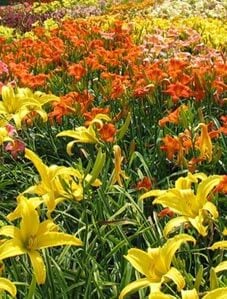
Soils: Daylilies will grow in a wide range of soils, from sand to heavy clay, and in a wide range of soil pHs. There are steps you can take to improve your soil, especially if it is predominantly clay or sand. Clay soils can be improved by the addition of compost, humus or peat moss, or sand which will help make it more friable. Sandy soil will benefit from the addition of compost, humus or peat moss which will serve to increase water retention.
Drainage: Daylilies prefer well-drained soil. In problem areas, one way to achieve adequate drainage is to prepare raised beds.
Other Plants: To avoid root competition for water and nutrients, do not plant daylilies near shrubs or trees if possible. If you can’t avoid it, be sure to give them extra water and fertilizer to make up for what the other plants take. An exception is in the South, where daylilies perform well under pine trees, benefiting from their dappled shade.
To help prepare for your daylilies, work your ground in advance, incorporating organic material such as compost or well-rotted manure if possible.
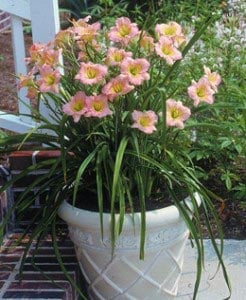
Yes, but you have to make sure to have a large enough container, and you have to keep them well-watered (every day in the summer heat). For smaller-stature plants (typically the ones with smaller blooms), you’ll want at least a 12″ diameter pot, 15-18″ will be better. Larger varieties will need larger pots.
In zone 7 or colder, you will need to protect your potted daylilies over the winter. Here at our nursery, in zone 6/7, we put our potted daylilies in an unheated cold frame. Other options for protection would be to bunch pots together and cover with straw, or to put in a crawl space or garage. The colder your winters, the more protection they will need, because daylilies may very well die if your pots freeze solid.
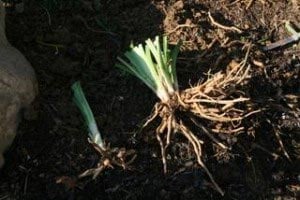
You can divide any daylily clump that has two or more plants (fans), but you typically would want to wait until the clump was large enough to make at least two good-sized units with at least 3 fans each. If you divide them too small (like the plant on the left in the far right picture), they probably won’t bloom for a season or two. For more information on How To Divide Daylilies, visit our YouTube page for video instructions.
Daylily plants come in a wide range of sizes, but here are some general guidelines to follow:
• Small Flower & Miniatures: 16″ to 24″
• Large Flowers: 18″ to 30″
• For a closer bed or border: 12″ to 18″
Some varieties increase very rapidly and will become crowded over time; sooner the closer you plant them. If you notice a decrease in blooms because of crowding you will want to divide your daylilies.
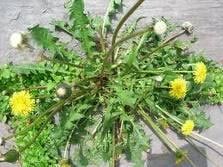
Mulching your daylilies and hand weeding are the best ways to control weeds in daylilies. They aren’t too particular about what kind of mulch. There are chemicals available to control grasses in daylilies, check with your local extension agency or garden center for what is available in your area.
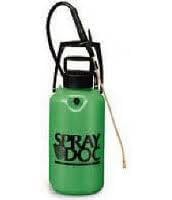
Typically, no. We usually get this question when someone notices damage on their daylily blooms, perhaps caused by thrips or aphids, and usually early in the bloom season. We occasionally have some damage in our display garden (such as spotted or misshapen blooms), but we’ve found that after the first few days of the season we don’t see that damage anymore. So, we don’t spray our daylilies with anything. Feel free to give us a call or email with any additional spraying-related questions.
Daylilies aren’t picky about fertilizer. We typically use a high quality, nitrogen rich fertilizer each spring before the daylilies begin to bloom. Slow release fertilizer, liquid fertilizer, compost or well-rotted manure are all good choices as well. Daylilies love nitrogen so it’s important to use a mix that is high in nitrogen. It is always a good idea to have a soil test done, especially if you feel like you have an unusual soil situation.
Are you a visual learner?
You need to visit our YouTube channel! Our videos are short but informative and cover a range of topics. PLUS—we are always adding new ones! If you are interested in How to Plant Daylilies, the difference between Evergreen and Dormant varieties (and which is the right fit for your garden) or 30 seconds with Orange Vols (and other daylily varieties), we’ve got you covered!
Daylily Growing Guide! How to Plant, Grow and Divide Daylilies // Bare Root Daylilies
FAQ
What grows well next to daylilies?
Yarrow, Coneflowers, and Red Hot Poker are ideal long-blooming partners. All manner of early spring perennial bulbs can be planted with Daylilies.Aug 28, 2023
How do you landscape with daylilies?
Daylilies are vigorous plants that multiply over time. Plants that are initially a foot apart will gradually fill in to create a weed-resistant border. You can plant a single cultivar, plant blocks of two or more different cultivars, or plant a random mix of many different colors, heights and bloom times.
Do daylilies like to be crowded?
Spacing. Some varieties increase very rapidly and will become crowded over time; sooner the closer you plant them. If you notice a decrease in blooms because of crowding you will want to divide your daylilies.
What not to plant with lilies?
